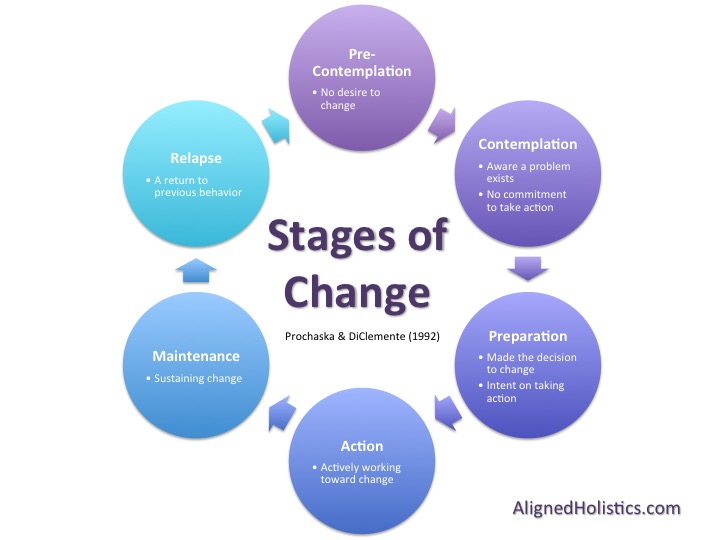I’m the first to admit that I don’t do well with change. I don’t like uncertainty and I don’t like people who tell me to “patiently wait,” “surrender,” or “carry snacks if you’re going to be that hangry.”
I’m a meditator who moonlights as a list-making, control freak.
So it was no surprise that while working with a client on her “Action Plan for Change,” a lightbulb went off. Most people want change, but never achieve it. Either they don’t have the support, structure, or science to create lasting results. I need to give my readers the behind-the-scenes tool I use to help clients stop second-guessing and take meaningful action.
In my training to transition from coach to therapist, I’ve learned countless approaches and theories on change. Today, I want to share the “Stages of Change Model.” Designed to modify behaviors and address motivational challenges, it determines which actions you should take based on your level of readiness.
Why should this matter to you? Because understanding your readiness to change will help you to:
Find Answers Make decisions Stop judging yourself Take action Be okay with not always being okay
Addressing Ambivalence:
Everyone feels ambivalent at times. Often, we want 2 things that can’t coexist:
You want to leave your job, but you’re scared you won’t find anything else. You’re unhappy in your relationship, but you don’t want to go on another first date. You can’t decide between the warm comfort of pizza and the sweet siren song of a brownie.
The anxiety we feel before making a decision and the second-guessing that ensues is all part of the human experience. This is especially true when it comes to major life changes. The key to overcoming ambivalence and taking action is assessing your readiness to change.

How The "Stages Of Change" Work:
It’s a circle, not a line. This isn’t geometry lesson, it’s an annoying fact of life. Growth isn’t linear and neither is change. We move through the stages in an upward spiral. Pre-contemplation is the stage where you aren’t thinking about making a change. Maybe you don’t see something as a problem, maybe it’s not that bad yet, or maybe you’re rationalizing it. Either way, this is the stage where you have no motivation to change because you don’t think there’s anything to change. Contemplation is the stage where you’re on the fence. You’ll consider the possibility that maybe you might what to change, but you’re ambivalent. You haven’t made a decision, but you’re open (even if reluctantly) to the idea that a change might be warranted. In the Preparation Stage you’ve made the decision to change and are making plans to change the behavior or situation that isn’t serving you. In the Action Stage, you’re implementing your plan, continuing to adjust it as needed. In the Maintenance Stage, you’re a few months into the change or new behavior. It’s getting easier and beginning to feel more natural. In the Relapse Stage, you’ve taken a detour to your old behavior or situation. Whether it’s stress, transition or anything else, relapse is natural. It is a normal and necessary part of change, strengthening your resolve to a greater degree.
5 Steps To Create Change:
1. Determine your stage after reviewing the diagram above.
2. Strengthen your will to change by tapping into the reasons why you want to change now. Motivation is an emotion. Like any emotion, it can wax and wane. Learn how to maintain motivation here .
3. Choose from the following:
If you’re in the Contemplation Stage - Consider the advantages and disadvantages of making a change. Think back to previous attempts to change and the ways these methods helped or fell short. Use this tool to guide you . If you’re in the Preparation Stage - Make a realistic plan. I can’t tell you how many times I’ve told my clients (and myself) that sustainable change doesn't happen overnight. Set yourself up for success by creating a start to finish plan that anticipates and addresses the challenges you faced when you made a previous attempt. It may be helpful to talk through your plan with a therapist, coach, or trusted advisor. If you’re in the Action or Maintenance Stages - Follow you plan and adjust it as necessary. Reach out for support. Change isn’t easy. Nobody gets to where they are alone. If you’re in the Relapse Stage - Focus on self-forgiveness and reach out for support. You may be tempted to give up your plan, but remember that this is an opportunity to learn what doesn’t work and alter it accordingly.
4. When you feel ambivalent or lose motivation, amplify the parts of you that want to create change while acknowledging the feelings that have previously kept you stuck. Tell yourself “Even though I would rather watch TV than go for a walk, I know I will feel better after I start.” Then, go back to y our list of motivating reasons .
5. Reach out for support. Your friends and family want you to succeed! And while most of us suck at asking for help, new results come from taking new actions.
The Takeaway:
Your awareness and motivation are the keys to beating ambivalence and creating lasting change. If you’re still on the fence about making a change, it’s better to clarify and plan than to go full steam ahead. Success comes from taking steps that align with your readiness to change.


